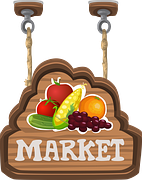Transport - Goods & Shopping
Shop Local
Transport not only concerns the movement of people, it also relates to the movement of goods so our consumption patterns are also closely linked with the issue of travel.

Food miles

How often have you gone into a supermarket and come home with apples from New Zealand instead of fruit that was produced locally?
Every product that is not made or produced in your local area has to be transported from a farm or production site, to a factory or processors, to a distribution centre, to an airport, to another airport, to another distribution centre, to your local shop or supermarket. Think of the ‘food miles’ attached to something as simple as an apple! Have a look at the labels on your clothes and furniture to see where they come from. Often produce from far away is chosen for its ability to 'travel well' rather than for its taste! It is often picked when it is still unripe and artificially ripened along the many miles it has to travel to make it to our supermarkets. Road freight experienced the largest growth in transport energy use since 1990 increasing by 255%.
Local Food & Local Goods

Would it be possible to source any of the products you use in your home from a local supplier?
- You’d be reducing the energy used to bring that product to you, as well as supporting your local economy.
- Considering that we are heavily dependent on imported oil products for transport energy (99%, SEAI 2014), sourcing products locally would be a step towards self-sufficiency.
- Consider buying food from your local famers' market or country market - it is likely that the goods have been grown or produced close to your home and if in doubt, you can always ask the seller! Visiting markets is a great way to get the freshest local produce and mingle with the community while supporting local producers - again, asking the stall holder about the origin of the goods is often the only way to find out where the produce comes from.
Supermarket shopping

When you are in the supermarket, try to buy the fruit and vegetables that have been grown in Ireland. You'd be surprised to see on display, strawberries from both Ireland and the USA; tomatoes from both Ireland and Spain, potatoes from both Israel and Ireland, etc. Buying the Irish food guarantees that the transport costs are lower, the food is likely to be fresher and have more flavour and your choice will help support home industries.